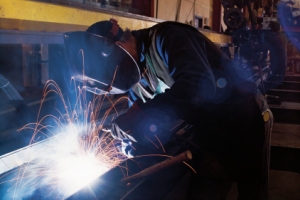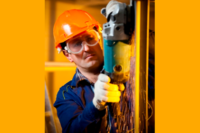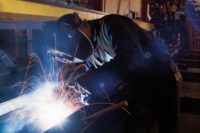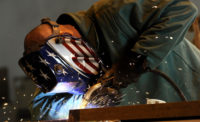 Welding is the result of a combination of heat and pressure to melt materials joining them with a filler material. It can be performed in many ways using different energy sources gas flame, electric arc, laser, friction, ultrasound & electric beam. Arc welding is a basic welding process which requires a power supply, electrodes, welding rods, shielding gas, and proper safety equipment.
Welding is the result of a combination of heat and pressure to melt materials joining them with a filler material. It can be performed in many ways using different energy sources gas flame, electric arc, laser, friction, ultrasound & electric beam. Arc welding is a basic welding process which requires a power supply, electrodes, welding rods, shielding gas, and proper safety equipment.
Although the welding process is common, it may also be a potentially dangerous one.
Protective equipment is the most important requirement for persons engaged in a welding activity, since an open electric arc or flame is often involved and the probability of injury is great.
Obviously the greatest threat is the high risk of getting burnt. To avert such risks, protective clothing such as heavy duty leather gloves and thick long sleeved coveralls must be used.
In addition to possible burns, severe eye damage can also occur. Welders can prevent this by wearing protective goggles, masks, and helmets which have specially designed dark or self darkening lenses & face plates. These lenses reduce the possibility of the negative effects of ultra violet rays to the operator’s eyes from sparks and/or arcs when using electric welding methods.
Welders stand the chance of getting exposed to toxic gases & fine particles. These are in the form of welding smoke produced during welding which is detrimental to clean breathing conditions. Exposure to gases and fumes which are capable of subjecting the human body to long term ailments must be avoided.
When bottles of flammable compressed gases are used, there is a potential risk of fire or explosion when open electric arcs or flame is in close proximity. For this reason it is best to segregate arc and gas welding processes such as having a different room for each if possible. Doing so is the best way to prevent such risky situations.
Welding is a complex subject and a thorough study of it before one begins the craft cannot be overstressed. The most commonly used, easy to access welding operation today is arc welding. There are many types of arc welding, but two of the most common are MIG welding (also known as Gas Metal Arc Welding or GMAW) & TIG (also known as Gas Tungsten Arc Welding or GTAW) welding.
There cannot be two opinions that safety should be the prime consideration when starting any trade like welding where the risk for physical injuries is very high.
A lot of industrial accidents can be averted if tradesmen like welders take the issue of safety seriously and use the necessary safety accessories like clothing, boots, helmets, welding gloves, safety glasses etc. Welders must take note that welding safety accessories exist because welding, when done casually and in an unguarded manner, can be hazardous.
The causes of potential injuries from welding are: electric shock, obnoxious fumes, Arc fire sparks, fire, sudden explosion, flying metal pieces, intense visible and invisible light, etc. The ultraviolet and infrared light rays have the potential to burn your skin more intensely than sunburn, and can damage your eyes. Sparks and spatter can burn your skin, your hair and your clothes.
However, when proper safety procedures are followed and the recommended safety gadgets are used, welding can be a good avocation.
Since welding produces oppressive heat and generates hot sparks, it is important to wear the proper work shirts made of thick heavy materials such as heavy cotton or denim that is not easily inflammable. The work pants should be close fitting and made of a heavy material such as work jeans. Overalls are appropriate if other clothing is worn under them.
High top leather boots are recommended for welders. Canvas boots or dress shoes should be scrupulously avoided. Wear heavy work socks for added protection against sparks. Safety boots with steel toe caps are advisable to protect the feet.
The welding helmet is designed to protect the welders face and head from the ultraviolet and infrared rays of the welding arc, while allowing the welder to view the molten weld pool or puddle. From amongst different types of welding helmets available in the market, the ones with the flip front is helpful. The flip front allows the welder to view the weld area through a clear lens, while still wearing the helmet.
The Auto darkening helmets are especially useful as they have lens that are clear to allow the welder to see the joint before striking the arc. As soon as the welder strikes the arc, the lens darkens to the normal view of the welding puddle.
The welding gloves required for welding are the gauntlet type gloves that cover the forearms. Lightweight gloves designed for TIG give the welder a better feel for manipulating the TIG torch and adding filler wire. The TIG gloves are however not suitable for STICK or MIG welding.
Safety glasses are mandatory for all welding work as they protect the eyes from the intense ultraviolet and infrared rays of the welding arc. It is important to know that the safety glasses must have side shields to protect the corner of the eye when welders are working close by.
A welding cap protects the head from sparks flying over the welding helmet and from falling sparks while welding overhead. A cap with no peak called a beanie is a popular choice for welders. A cap with a peak worn backward may also be used.
Safety is everyone’s business, never compromise on safety aspects to get any welding job done hurriedly. Please bear in mind that an industrial accident can irreparably ruin your career and future.
While welding is a valuable skill to possess, it is important to get the right machine to do the job. If you are a professional or a hobbyist and are trying to find the machine to fit your needs. We offer a full line of welders for the hobbyist and professionals, including MIG, TIG, STICK and plasma cutters.
Summary
Welding involves a wide range of tasks and hence a wide range of health and safety hazards, which include the following:
- chemical dusts, fumes, vapours and gases
- poor ergonomic working conditions
- electrical hazards
- falls, trips, falling objects
- moving vehicles and cranes
- operating machinery
- arc light radiation, which can expose welders to intense ultraviolet, visible and infrared light
- oxygen displacement, oxygen enrichment or flammable gas mixtures from leaking compressed gas lines and cylinders
- heat, sparks, spatter, open flames and hot surfaces
- noise from metal-on-metal impacts, materials handling, metal working and some welding processes
- confined spaces
Mma (manual metal arc welding)
MMA (manual metal arc welding) is the most common and diffused way of welding. It functions by using an additional material, that fills the gap existing between the 2 parts to be welded. This filling metal is commercialised in the form of electrodes.
Electros have a core of metal, and an external coating, which is the insulating material. When welding with electrodes, the arc generated from the current smelts the internal metal (creating the welding bath), but also the insulating material round on it, letting In this way the procedure be safe from external agents presents in the air, that could damage the welding
TIG (Tungsten inert gas welding) allows the joining of two metal parts, without using any additional material. It functions by heating the parts to be welded with a torch, which is equipped with a special permanent electrode in Tungsten.
The arc generated by this torch allows the two parts be smelted and joined, obtaining a very clean result. For this reason, Tig is used especially when there is the intention to reduce to the minimum the permanent sign left from the welding procedure.
In order to insulate the welding bath is used the gas (normally argon), that comes out from the torch during the welding, round on the tungsten core.
Tig welding involves 3 main different modes: HF, LA, Scratch (here below described), and two different machines: DC and AC/DC
TIG HF. Is the best way of welding in TIG. You have on the devices all the parameter controls for current and gas, the High Frequency allows to start welding in the exact point wished, without touching the metal. The torch has a special connection to the machine. Once you have settled the machine,
you position the torch near the start point, you push a switch on the torch and the welding starts.
TIG LA. The torch is different from the HF Torch, is very simple, and must be connected to the minus dinse of the machine. There is a tap on the torch to open the gas. The lift-arc-function allows to touch the exact point on which is wished to weld, but without starting immediately the welding. In this way is possible to be more precise. Once you have found the exact point to start, you remove the torch of some millimeters, and the machine starts welding. In this way is also reduced the risk of contamination.
TIG Scratch. The torch is exactly the same as the one seen before, with the gas tap, and must be connected to the minus dinse. The welding starts by touching the metal part. The quality is OK, but can't be compared with the HF, because by touching the metal in order to start, is not easy to start exactly in the wished point. Is also to remark that with this kind of welding, some Tungsten rests could remain in the welding.
MIG (Metal Inert gas welding) is the preferred way of welding from people that needs to weld for long time. In fact, the additional material is not in the form of electrodes, but in the form of a wire, that through an electric motor is pulled in a continuous way into the torch, from which it comes out together with the protecting gas round on it (in order to avoid contamination). The wires are available in different metal leagues in order to match the right welding combination, and are stored on rolls. The rolls can be of 5 or 15 Kg
Welding Machines
The welding machine is in practice a sophisticated generator of current, that functions by transforming the main supply into an arc of current suitable for the welding activity. The tradition and story of welding is represented by the “transformer devices”, now considered primitive machines because of their weight and of the reduced possibility of changing the functioning parameters, also dissipating and wasting a lot of energy into heat.
The new technology, a real revolution in the welding field, is known with the name “inverter technology”. It uses hi-tech very sophisticated electronic elements in order to increase the frequency until very high values, permitting to reduce in an extreme way the weight and dimensions of the machines
When speaking about inverter technology, the first aspect mentioned is normally the drastic reduction in energy consumption. It is in fact certified that the usage of this technology allows to reduce until 40%, sometimes 50% the consumption. This is but not only an economical aspect. Using less energy means also the possibility to connect equipments with professional features to the normal 220 VAC network, as well as the possibility of using more equipments together in the same working place.
This advantage is reached with a consistent reduction in weight and dimensions, that implicated a revolution in the usage and transport of welding equipments in the last years. These aspects are surely interesting in a comparison, especially when speaking with not too professional welders, but represents not yet the biggest advantage of the inverter technology, which is the possibility of setting the welding current as wished, without any predefined step, with an extreme fine range. With inverters, the welder can always find the wished working current , not an ampere less or an ampere more. This is the most interesting aspect, especially for those who makes of welding their main activity
Duty Cycle
Near the maximum Ampere indicated in the data sheet, there is normally the “%” of the device, called duty cycle, which is an international numerical value indicating the percentage of service from the generator. In a few words, it says how long the machine stays on, without the intervention of the thermostatic protection, which cuts off for some minutes the device.
When for example two devices are giving both 130 A, but one at 20%, the other at 40%, it means that the second will work at 130 A for the double of the time than the first. It represent a big difference, practically the distinction between a low cost machine, and a professional machine
This parameter, usually indicated as IP, indicates how protected is the device from external agents.
In our field the maximum IP to be found in the market is IP23. We reach on almost all models the IP23.
This parameter is indicated with IC, determines the level of insulation of the machine.
The absolute maximum level in the market is H, all our models have IC H
Inverter technology is expensive, and difficult to be used. Sometimes, producers not able to use correctly the inverter technology, try to hide in their machines hybrids cocktails, which can be immediately recognised by their weight: a light machine, giving 100 A, can weight maximum 4-5Kg, all the middle class between 130 A and 180 A can weight about 5-6 Kg, if you see similar products weighting 10 Kg, be careful, it means it is a product with a big transformer inside.
The big transformers means that the producer was not able to use correctly the inverter technology, the machine will dissipate a lot of energy in heat. When speaking of Tig machines, they can weight about 10-12 Kg if simple inverter, 30-40Kg when ACDC inverters Arc ForceGives a power source variable additional amperage during low voltage (short arc length) conditions while welding. Helps avoid "sticking" electrodes.
Hot Start Used on some Stick (SMAW) machines to make it easier to start electrodes. Used for arc starting only.
This feature allows TIG arc starting without high frequency. Starts the arc at any amperage without contaminating the weld with tungsten.
The lines cycle, special exclusive and big have a special function called standby: when on but not welding the devices turns automatically after 30 sec. , from an absorbed power of about 350 W with output 70 V to an absorbed power of 60 W with output 7 V.
By touching the piece with the electrode, the machines starts again working as before. Nothing to touch or set from the user, which can spare in this way about 1 Kw every 3 hours!
Rare metallic element with extremely high melting point (3410o Celsius). Used in manufacturing TIG electrodes.
More on welding techniques & types
Welders use many types of welding equipment set up in a variety of positions, such as flat, vertical, horizontal, and overhead. They may perform manual welding, in which the work is entirely controlled by the welder, or semiautomatic welding, in which the welder uses machinery, such as a wire feeder, to perform welding tasks.
There are about 100 different types of welding.
Arc welding is the most common type. Standard arc welding involves two large metal alligator clips that carry a strong electrical current. One clip is attached to any part of the workpiece being welded. The second clip is connected to a thin welding rod. When the rod touches the workpiece, a powerful electrical circuit is created. The massive heat created by the electrical current causes both the workpiece and the steel core of the rod to melt together, cooling quickly to form a solid bond. During welding, the flux that surrounds the rod’s core vaporizes, forming an inert gas that serves to protect the weld from atmospheric elements that might weaken it.
Welding speed is important. Variations in speed can change the amount of flux applied, weakening the weld, or weakening the surrounding metal by increasing heat exposure.
Two common but advanced types of arc welding are Tungsten Inert Gas (TIG) and Metal Inert Gas (MIG) welding. TIG welding often is used with stainless steel or aluminum. While TIG uses welding rods, MIG uses a spool of continuously fed wire, which allows the welder to join longer stretches of metal without stopping to replace the rod. In TIG welding, the welder holds the welding rod in one hand and an electric torch in the other hand. The torch is used to simultaneously melt the rod and the workpiece. In MIG welding, the welder holds the wire feeder, which functions like the alligator clip in arc welding. Instead of using gas flux surrounding the rod, TIG and MIG protect the initial weld from the environment by blowing inert gas onto the weld.
Like arc welding, soldering and brazing use molten metal to join two pieces of metal. However, the metal added during the process has a melting point lower than that of the workpiece, so only the added metal is melted, not the workpiece. Soldering uses metals with a melting point below 800 degrees Fahrenheit; brazing uses metals with a higher melting point. Because soldering and brazing do not melt the workpiece, these processes normally do not create the distortions or weaknesses in the workpiece that can occur with welding. Soldering commonly is used to join electrical, electronic, and other small metal parts. Brazing produces a stronger joint than does soldering, and often is used to join metals other than steel, such as brass. Brazing can also be used to apply coatings to parts to reduce wear and protect against corrosion.
Skilled welding, soldering, and brazing workers generally plan work from drawings or specifications or use their knowledge of fluxes and base metals to analyze the parts to be joined. These workers then select and set up welding equipment, execute the planned welds, and examine welds to ensure that they meet standards or specifications. They are even examining the weld while they’re welding. By observing problems with the weld, they compensate by adjusting the speed, voltage, amperage, or feed of the rod. Highly skilled welders often are trained to work with a wide variety of materials in addition to steel, such as titanium, aluminum, or plastics. Some welders have more limited duties, however. They perform routine jobs that already have been planned and laid out and do not require extensive knowledge of welding techniques.
Automated welding is used in an increasing number of production processes. In these instances, a machine or robot performs the welding tasks while monitored by a welding machine operator. Welding, soldering, and brazing machine setters, operators, and tenders follow specified layouts, work orders, or blueprints. Operators must load parts correctly and constantly monitor the machine to ensure that it produces the desired bond.
The work of arc, plasma, and oxy-gas cutters is closely related to that of welders. However, instead of joining metals, cutters use the heat from an electric arc, a stream of ionized gas (plasma), or burning gases to cut and trim metal objects to specific dimensions. Cutters also dismantle large objects, such as ships, railroad cars, automobiles, buildings, or aircraft. Some operate and monitor cutting machines similar to those used by welding machine operators. Plasma cutting has been increasing in popularity because, unlike other methods, it can cut a wide variety of metals, including stainless steel, aluminum, and titanium.
Source: WWW.WELDNBRAZE.COM EMAIL: SALES@WELDNBRAZE.COM OR JOHANNESBURG@VODAMAIL.CO.ZA



